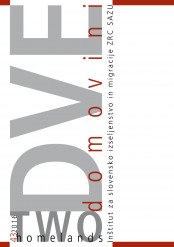Slovenian Emigrants and their Descendants in Germany: Twenty Years of Gatherings of the Slovenian Organizations at Conferences
DOI:
https://doi.org/10.3986/dd.2016.1.13Keywords:
Slovenian emigrants, Germany, gatherings of the Slovenian organizations in Germany, Slovenian associations in Germany, Slovenian classesAbstract
In the article, the emigration of Slovenians to Germany in the 2nd half of the 20th century and at the beginning of the 21st century is presented, and the cooperation of Slovenian organizations in Germany; the main focus is on gatherings. Partial results of the qualitative research are presented, this research is based on the participant observation of the last four gatherings, besides, semi-structured interviews were made with the organisers and the participants of the gatherings. The gatherings of Slovenian organisations in Germany have been organised once a year for twenty years (1996–2015). This special form of cooperation, which surpasses local operations of Slovene organisations, represents for Slovenian emigrants and their descendants an important way of maintaining Slovenian identity, socialising and professional support, at the same time it offers the possibility for connecting Slovenian organisations in Germany with Slovenia.
Downloads
References
Brunnbauer, Ulf (2009). Labour Emigration from the Yugoslav Region from the late 19th Centiry until the End of Socialism: Continues and Changes. Transnational societies, transterritorial politics: Migrations in the (Post-) Yugoslav region: 19th–21st century (ur. Ulf Brunnbauer). München: R. Oldenbourg, 17–49.
Castles, Stephen, Miller, Mark J. (2009). The Age of Migration: International Population Movements in the Modern World. New York: Guilford Press.
Drnovšek, Marjan (2008). Društveni arhivi v Nemčiji: Med preteklostjo in sedanjostjo. Arhivi 31/2, 251–261.
Drnovšek, Marjan (2009). Fragments from Slovenian migration history, 19th and 20th centuries. Transnational societies, transterritorial politics: Migrations in the (Post-) Yugoslav region: 19th–21st century (ur. Ulf Brunnbauer). München: R. Oldenbourg, 51–72.
Drnovšek, Marjan (2012). Slovenski izseljenci in zahodna Evropa v obdobju prve Jugoslavije. Ljubljana: Založba ZRC, ZRC SAZU.
Detela, Lev (1999). Francija, Nemčija, Španija, Avstrija. Slovenska izseljenska književnost 1: Evropa, Avstralija, Azija (ur. Janja Žitnik, Helga Glušič). Ljubljana: ZRC SAZU, Zaloba ZRC, Rokus, 189–190.
Jurkovič, Tatjana (4. 11. 2014). Informacija o pouku slovenščine za Slovence in njihove potomce v tujini, Ministrstvo za izobraževanje, znanost in šport Republike Slovenije, http://www.bern.embassy.si/fileadmin/user_upload/dkp_21_vbn/PDF_Files/Informacija_o_pouku_slovenscine.pdf (27. 12. 2015).
Koordinacija slovenskih društev v južni Nemčiji, https://koslovenija.wordpress.com/ (27. 12. 2015).
Lukšič Hacin, Marina (2001). Pomen kulturno-umetniške dejavnosti med slovenskimi izseljenci – Zahodna Evropa. Dve domovini / Two Homelands 14, 53–65.
Lukšič Hacin, Marina (2007). Normativni vidiki in delovne razmere za migrante v Zvezni republiki Nemčiji. Dve domovini / Two Homelands 25, 187–208.
Mirjam Milharčič Hladnik (2012). Medkulturni odnosi in socialne participacije v kontekstu migracij. Dve domovini / Two Homelands 36, 7–18.
Nećak, Dušan (2010). »Ostpolitik« Willyja Brandta in Jugoslavija (1966–1974). Ponovna vzpostavitev diplomatskih stikov med Zvezno Republiko Nemčijo in Jugoslavijo. Slovenija – Jugoslavija, krize in reforme 1968/1988 (ur. Zdenko Čepič). Ljubljana: Inštitut za novejšo zgodovino, 183–230.
Scheffer, Paul (2011). Immigrant Nations. Cambridge, Malden: Polity Press.
Slovenska društva, Veleposlaništvo Republike Slovenije v Berlinu, http://www.berlin.veleposlanistvo.si/ index.php?id=409&L=2Marta&no_cache=1&sword_list[]=dru%C5%A1tva (27. 12. 2015).
Slovenske katoliške misije v tujini, Nemčija (2013), Družina, http://www.druzina.si/ICD/spletnastran.nsf/ cerkvene-informacije/slovenske-katoliske-misije-v-tujini (27. 12. 2015).
Socioekonomske značilnosti meddržavnih selivcev, 2013, Slovenija, Statistični urad Republike Slovenije, http://www.stat.si/StatWeb/prikazi-novico?id=4772&idp=17&headerbar=15 (27. 12. 2015).
Selitveno gibanje, 2014, Slovenija, Statistični urad Republike Slovenije, http://www.stat.si/StatWeb/prikazi-novico?id=5318&idp=17&headerbar=15 (27. 12. 2015).
Šket, Janez, Turk, Ciril (ur.) (2000). Slovenci na Württemberškem – nova domovina v cerkvi. Ljubljana: Družina.
Štrubelj, Zvone (2009). Pogum besede, Primož Trubar, 500 let: 1508–2008. Celovec: Mohorjeva družba, Celje: Društvo Mohorjeva družba, Gorica: Goriška Mohorjeva družba.
Štumberger, Saška (2006). Dvojezičnost na primeru Slovencev v Nemčiji. Slavistična revija 54/1, 41–60.
Štumberger Saška (2007). Slovenščina pri Slovencih v Nemčiji. Ljubljana: Znanstvenoraziskovalni inštitut Filozofske fakultete.
Toplak, Kristina (2005). Umetniška ustvarjalnost migrantov: Primer Slovencev v Nemčiji. Dve domovini / Two Homelands 22, 115–127.
Toš, Niko (ur.) (2014). Vrednote v prehodu IX.: Iz zakladnice socioloških raziskav: Migracije Slovencev (1973– 1987) in socialne strukture jugoslovanske družbe (1983–1987). Ljubljana: Fakulteta za družbene vede, IDV-CJMMK; Dunaj: Echoraum.
Vižintin, Marijanca Ajša (2012). Poročilo s 17. Posveta slovenskih društev, katoliških misij, učiteljev, socialnih delavcev in članov folklornih skupin v Nemčiji (Bad Urach, 23.–25. 3. 2012). Dve domovini / Two Homelands 36, 177–178.
Vižintin, Marijanca Ajša (2014). Od kod prihajajo otroci priseljenci in čemu? Monitor ISH 16/2, 101–126.
Vižintin, Marijanca Ajša (2015a). Otroci in dopolnilni pouk slovenščine v Bosni in Hercegovini: Od jezika prednikov do jezika prihodnosti. Slovensko izseljenstvo v luči otroške izkušnje (ur. Janja Žitnik Serafin). Ljubljana: Založba ZRC, ZRC SAZU, 157–173.
Vižintin, Marijanca Ajša (2015b). 45 let društva Triglav Stuttgart, Medkulturni inštitut, http://medkulturni- -institut.si/45-let-drustva-triglav-stuttgart/ (27. 12. 2015).
Žitnik Serafin, Janja (2015). Recipročnost ali simetrija? Primerjava kulturnih interesov in možnosti dveh manjšin. Dve domovini / Two Homelands 42, 113–126.
Downloads
Published
How to Cite
Issue
Section
License

This work is licensed under a Creative Commons Attribution-NonCommercial-NoDerivatives 4.0 International License.
Authors guarantee that the work is their own original creation and does not infringe any statutory or common-law copyright or any proprietary right of any third party. In case of claims by third parties, authors commit their self to defend the interests of the publisher, and shall cover any potential costs.
More in: Submission chapter





